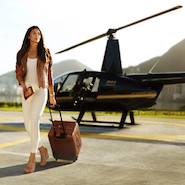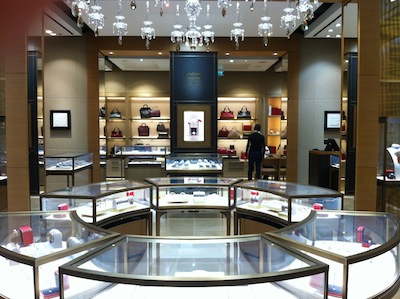 Affluent consumers spend when they travel; image courtesy of Michael Kors
Affluent consumers spend when they travel; image courtesy of Michael Kors
The number of outbound international travelers is projected to reach 1 billion by 2018, creating an opportunity for luxury brands to reach a global audience through airport retail placements, according to a report by Conlumino. With more airports, lower-cost airlines and bigger planes, international travel is becoming more accessible to less affluent consumers, especially those in emerging markets. Shopping is inherently linked to tourism, and airports offer brands a captive audience that is likely to be wooed by competitive prices.
"Airports are investing heavily in expanding and developing prime retail space in their airports and this now matches the standard luxury brands demand to showcase their brands," said Maureen Hinton, group research director at Conlumino, London.
"Meanwhile passenger traffic is rising and airports are ideal sites to raise international brands awareness to captive audiences," she said.
International appeal South Korea is currently the top market for duty-free, contributing 13 percent, or $6.3 billion, to the current $49 billion market. China closely follows, with the Asian Pacific region making up 43 percent of the total duty-free market. As it opens more airports and duty-free stores in cities, China is set to grow past South Korea by 2019 to become the largest duty-free market. An expanding Chinese middle class may also boost both business and leisure travel outside of the mainland. Also in the top 10 are the United States, the United Kingdom, Hong Kong, the United Arab Emirates, Singapore, Germany, France and Saudi Arabia. Cartier boutique at Heathrow
The duty-free market is projected to grow by 51 percent over the next five years, reaching $76.3 billion by 2019.
Asia-Pacific and the Middle East and Africa are going to see the steepest increases in number of international travelers. Asia Pacific will add the most travelers, with 142 additional outbound tourists in 2018 than 2014.
Europe will continue to have the most citizens traveling internationally over the next five years.
In an effort to capture the growth, airports such as London's Heathrow, Changi in Singapore and Schipol in Amsterdam have added retail space.
British retailer Fortnum & Mason has announced its first standalone airport store within Heathrow Airport.
Fortnum & Mason’s new space in the airport is housed in Terminal 5. As the busiest airport in all of Europe, and the fifth busiest in the world, Heathrow is an ideal space for a brand looking to make an impression on international travelers (see story).
Airport retailers have also revamped their spaces, making them more attractive partners for luxury brands.
Cartier boutique at Heathrow
The duty-free market is projected to grow by 51 percent over the next five years, reaching $76.3 billion by 2019.
Asia-Pacific and the Middle East and Africa are going to see the steepest increases in number of international travelers. Asia Pacific will add the most travelers, with 142 additional outbound tourists in 2018 than 2014.
Europe will continue to have the most citizens traveling internationally over the next five years.
In an effort to capture the growth, airports such as London's Heathrow, Changi in Singapore and Schipol in Amsterdam have added retail space.
British retailer Fortnum & Mason has announced its first standalone airport store within Heathrow Airport.
Fortnum & Mason’s new space in the airport is housed in Terminal 5. As the busiest airport in all of Europe, and the fifth busiest in the world, Heathrow is an ideal space for a brand looking to make an impression on international travelers (see story).
Airport retailers have also revamped their spaces, making them more attractive partners for luxury brands.
 DFS in JFK
LVMH-owned luxury travel retailer DFS Group is transforming its airport retail stores across North America to more accurately reflect location sensibilities and refine the focus of each space.
The latest project upgraded nine of the brand’s retail spaces in New York’s John F. Kennedy International Airport’s terminal four where the retailer is the sole duty-free operator. By customizing the function of each space, the brand will likely maximize traffic as consumers will not feel as if they are encountering repeats (see story).
Shopping habits
More than 60 percent of travelers who visit a duty-free outlet in an airport spend 15 minutes or less, making product presentation and customer service paramount to reach them in the short timeframe.
Consumers spend the most on jewelry, briefcases, men’s bags and handbags.
Dior was a top brand sought out in airport outlets, with 92 percent of respondents saying they intend to buy something from the brand within 2015.
DFS in JFK
LVMH-owned luxury travel retailer DFS Group is transforming its airport retail stores across North America to more accurately reflect location sensibilities and refine the focus of each space.
The latest project upgraded nine of the brand’s retail spaces in New York’s John F. Kennedy International Airport’s terminal four where the retailer is the sole duty-free operator. By customizing the function of each space, the brand will likely maximize traffic as consumers will not feel as if they are encountering repeats (see story).
Shopping habits
More than 60 percent of travelers who visit a duty-free outlet in an airport spend 15 minutes or less, making product presentation and customer service paramount to reach them in the short timeframe.
Consumers spend the most on jewelry, briefcases, men’s bags and handbags.
Dior was a top brand sought out in airport outlets, with 92 percent of respondents saying they intend to buy something from the brand within 2015.
"Dior is a luxury heritage brand that is universally recognized, and its success in duty-free is primarily through its fragrance and cosmetics products that provide an entry point to retail," Ms. Hinton said. "We are already seeing other luxury brands developing their beauty offers."
Respondents frequently mentioned competitive or discounted prices and availability of luxury products as the reasons they would buy within an airport. Exclusive offerings can also spur conversions, such as The Dalmore’s exclusive Scotch whisky for DFS (see story). Shopping tourism is growing, but to best reach these potential consumers, fashion brands and retailers should begin marketing to them before they leave their home country, according to a report from Fashionbi. Just as travelers heavily research hotels, restaurants, sites and entertainment before embarking on a trip, they are also using online media to plan their shopping excursions. Brands should ensure they are catering to their potential international clientele with Web sites in their native languages and social accounts on the platforms popular in different markets (see story). In addition to planning ahead, the right retail strategy and product selection can help boost sales."Have the right products – accessories, beauty, leather goods and gifts are all easy to buy on impulse as no problems on fit, for instance," Ms. Hinton said.
Final Take Sarah Jones, staff reporter on Luxury Daily, New York